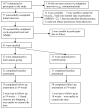A community-based fitness and mobility exercise program for older adults with chronic stroke: a randomized, controlled trial
- PMID: 16181164
- PMCID: PMC3226792
- DOI: 10.1111/j.1532-5415.2005.53521.x
A community-based fitness and mobility exercise program for older adults with chronic stroke: a randomized, controlled trial
Abstract
Objectives: To examine the effects of a community-based group exercise program for older individuals with chronic stroke.
Design: Prospective, single-blind, randomized, controlled intervention trial.
Setting: Intervention was community-based. Data collection was performed in a research laboratory located in a rehabilitation hospital.
Participants: Sixty-three older individuals (aged > or = 50) with chronic stroke (poststroke duration > or = 1 year) who were living in the community.
Intervention: Participants were randomized into intervention group (n=32) or control group (n=31). The intervention group underwent a fitness and mobility exercise (FAME) program designed to improve cardiorespiratory fitness, mobility, leg muscle strength, balance, and hip bone mineral density (BMD) (1-hour sessions, three sessions/week, for 19 weeks). The control group underwent a seated upper extremity program.
Measurements: Cardiorespiratory fitness (maximal oxygen consumption), mobility (6-minute walk test), leg muscle strength (isometric knee extension), balance (Berg Balance Scale), activity and participation (Physical Activity Scale for Individuals with Physical Disabilities), and femoral neck BMD (using dual-energy x-ray absorptiometry).
Results: The intervention group had significantly more gains in cardiorespiratory fitness, mobility, and paretic leg muscle strength than controls. Femoral neck BMD of the paretic leg was maintained in the intervention group, whereas a significant decline of the same occurred in controls. There was no significant time-by-group interaction for balance, activity and participation, nonparetic leg muscle strength, or nonparetic femoral neck BMD.
Conclusion: The FAME program is feasible and beneficial for improving some of the secondary complications resulting from physical inactivity in older adults living with stroke. It may serve as a good model of a community-based fitness program for preventing secondary diseases in older adults living with chronic conditions.
Figures
Similar articles
-
The Effects of a Motorized Aquatic Treadmill Exercise Program on Muscle Strength, Cardiorespiratory Fitness, and Clinical Function in Subacute Stroke Patients: A Randomized Controlled Pilot Trial.Am J Phys Med Rehabil. 2018 Aug;97(8):533-540. doi: 10.1097/PHM.0000000000000920. Am J Phys Med Rehabil. 2018. PMID: 29533252 Clinical Trial.
-
Reduced hip bone mineral density is related to physical fitness and leg lean mass in ambulatory individuals with chronic stroke.Osteoporos Int. 2005 Dec;16(12):1769-79. doi: 10.1007/s00198-005-1925-1. Epub 2005 May 19. Osteoporos Int. 2005. PMID: 15902416 Free PMC article.
-
Water-based exercise for cardiovascular fitness in people with chronic stroke: a randomized controlled trial.Arch Phys Med Rehabil. 2004 Jun;85(6):870-4. doi: 10.1016/j.apmr.2003.11.001. Arch Phys Med Rehabil. 2004. PMID: 15179638 Free PMC article. Clinical Trial.
-
Physical fitness training for stroke patients.Cochrane Database Syst Rev. 2020 Mar 20;3(3):CD003316. doi: 10.1002/14651858.CD003316.pub7. Cochrane Database Syst Rev. 2020. PMID: 32196635 Free PMC article.
-
Comparing Two Types of Exercise Classes to Help Older Adults Improve Walking Ability [Internet].Washington (DC): Patient-Centered Outcomes Research Institute (PCORI); 2018 Mar. Washington (DC): Patient-Centered Outcomes Research Institute (PCORI); 2018 Mar. PMID: 36924509 Free Books & Documents. Review.
Cited by
-
Effect of Exercise Training or Complex Mental and Social Activities on Cognitive Function in Adults With Chronic Stroke: A Randomized Clinical Trial.JAMA Netw Open. 2022 Oct 3;5(10):e2236510. doi: 10.1001/jamanetworkopen.2022.36510. JAMA Netw Open. 2022. PMID: 36227593 Free PMC article. Clinical Trial.
-
Changes in physical health among participants in a multidisciplinary health programme for long-term unemployed persons.BMC Public Health. 2009 Jun 19;9:197. doi: 10.1186/1471-2458-9-197. BMC Public Health. 2009. PMID: 19545364 Free PMC article.
-
Utility and usability of a wearable system and progressive-challenge cued exercise program for encouraging use of the more involved arm at-home after stroke-a feasibility study with case reports.J Neuroeng Rehabil. 2024 Apr 30;21(1):66. doi: 10.1186/s12984-024-01359-0. J Neuroeng Rehabil. 2024. PMID: 38685012 Free PMC article.
-
Physical Activity and Sport for Acquired Brain Injury (PASABI): A Non-Randomized Controlled Trial.Medicina (Kaunas). 2021 Jan 29;57(2):122. doi: 10.3390/medicina57020122. Medicina (Kaunas). 2021. PMID: 33572946 Free PMC article. Clinical Trial.
-
Fitness and Mobility Exercise (FAME) Program for stroke.Top Geriatr Rehabil. 2010;26(4):310-323. doi: 10.1097/TGR.0b013e3181fee736. Top Geriatr Rehabil. 2010. PMID: 22287825 Free PMC article.
References
-
- Mol V, Baker D. Activity intolerance in the geriatric stroke patient. Rehabil Nurs. 1991;16:337–343. - PubMed
-
- Garrett NA, Brasure M, Schmitz KH, et al. Physical inactivity. Direct cost to a Health Plan. Am J Prev Med. 2004;27:304–309. - PubMed
-
- Feigin VL, Lawes CM, Bennett DA, et al. Stroke epidemiology: a review of population-based studies of incidence, prevalence, and case-fatality in the late 20th century. Lancet Neurol. 2003;2:43–53. - PubMed
-
- Jorgensen HS, Nakayama H, Raaschou HO, et al. Stroke: Neurologic and functional recovery. The Copenhagen Study. Phys Med Rehabil Clin N Am. 1999;10:887–906. - PubMed
Publication types
MeSH terms
Substances
Grants and funding
LinkOut - more resources
Full Text Sources
Other Literature Sources
Medical


